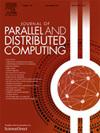Power, energy, and performance analysis of single- and multi-threaded applications in the ARM ThunderX2
IF 4
3区 计算机科学
Q1 COMPUTER SCIENCE, THEORY & METHODS
引用次数: 0
Abstract
Energy efficiency has been a major concern in data centers, and the problem is exacerbated as its size continues to rise. However, the lack of tools to measure and handle this energy at a fine granularity (e.g., processor core or last-level cache) has translated into slow research advances in this topic. Understanding where (i.e., which components) and when (the point in time) energy consumption translates into minor performance improvements is of paramount importance to design any energy-aware scheduler. This paper characterizes the relationship between energy consumption and performance in a 28-core ARM ThunderX2 processor for both single-threaded and multi-threaded applications.
This paper shows that single-threaded applications with high CPU activity maintain their performance in spite of the inter-application interference at shared resources, but this comes at the expense of higher power consumption. Conversely, applications that heavily utilize the L3 cache and memory consume less power but suffer significant performance degradation as interference levels rise.
In contrast, multi-threaded applications show two distinct behaviors. On the one hand, some of them experience significant performance gains when they execute in a higher number of cores with more threads, which outweighs the increase in power consumption, leading to high energy efficiency.
ARM ThunderX2中单线程和多线程应用程序的功耗、能源和性能分析
能源效率一直是数据中心的一个主要问题,随着数据中心规模的不断扩大,这个问题变得更加严重。然而,由于缺乏精确测量和处理这些能量的工具(例如,处理器核心或最后一级缓存),导致该主题的研究进展缓慢。了解能耗在哪里(即哪些组件)以及何时(时间点)转化为较小的性能改进,对于设计任何能感知能耗的调度器都是至关重要的。本文描述了28核ARM ThunderX2处理器在单线程和多线程应用中的能耗与性能之间的关系。本文表明,尽管在共享资源上存在应用程序间的干扰,具有高CPU活动的单线程应用程序仍能保持其性能,但这是以更高的功耗为代价的。相反,大量使用L3缓存和内存的应用程序消耗较少的功率,但随着干扰水平的提高,性能会显著下降。相反,多线程应用程序表现出两种不同的行为。一方面,当它们在更多的内核和更多的线程中执行时,其中一些会获得显着的性能提升,这超过了功耗的增加,从而实现高能效。
本文章由计算机程序翻译,如有差异,请以英文原文为准。
求助全文
约1分钟内获得全文
求助全文
来源期刊

Journal of Parallel and Distributed Computing
工程技术-计算机:理论方法
CiteScore
10.30
自引率
2.60%
发文量
172
审稿时长
12 months
期刊介绍:
This international journal is directed to researchers, engineers, educators, managers, programmers, and users of computers who have particular interests in parallel processing and/or distributed computing.
The Journal of Parallel and Distributed Computing publishes original research papers and timely review articles on the theory, design, evaluation, and use of parallel and/or distributed computing systems. The journal also features special issues on these topics; again covering the full range from the design to the use of our targeted systems.
 求助内容:
求助内容: 应助结果提醒方式:
应助结果提醒方式:


